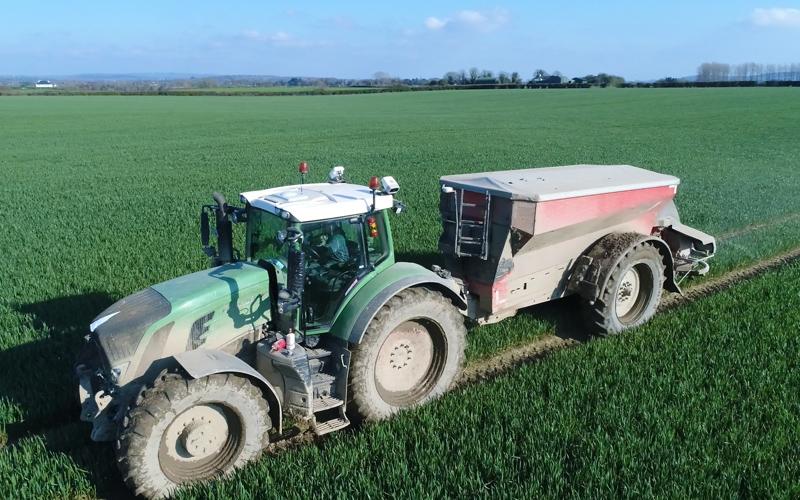When we caught up with James O'Reilly on a sunny morning in early April, he was top-dressing his Husky winter oats. The crop had come through the winter in great condition and the cool weather earlier in spring helped to slow down development. This was welcomed as he felt that the oats were a little too advanced.
He was applying round 260kg/ha of SulCAN, to finish the last of the crops nitrogen applications by GS32.
New ALS2 N sensor
He uses a Fendt 939 and trailed 10t Rauch Axent 100.1 spreader. Earlier in February, James took delivery of a new Yara ALS2 (active light sensor) nitrogen sensor, the first in the country.
The Yara N-Sensor is a real-time variable rate nitrogen sensor that allows growers to measure crop nitrogen requirement as the fertiliser spreader passes across the field and adjusts the fertiliser application rate accordingly.
It works by detecting the levels of light reflected from the crop and using this data to generate NDVI vegetation index maps, which are used to guide N applications.
The advantages of the new ALS2 over the previous sensors is that they are capable of working at night and can work when the crop is damp or has a heavy dew on it.
“To show how it worked, I went into a field at 4 o’clock in the evening and went to a number of points to see what nitrogen it [the sensor] was reading in the crop. I then went back in at 2 o’clock in the morning and went to the exact same spots and the readings were the same,” he says.
When spreading nitrogen using the sensors, he first puts in a minimum and maximum rate. The sensor then varies the rate of the spreader depending on the nitrogen present in the crop and working within the preset parameters.
The proof will be at harvest time
The idea of the sensor isn’t necessarily to save nitrogen, explains James, but to apply it where it’s needed and less of it where it’s not.
He expects to see more even crops closer to harvest time and hopes to see an increase in yield.
Ultimately, the proof that the sensor is worthwhile will be when he puts the combine through the field. To pay for itself, James estimates he would have to see 0.5% increase in yield.
“We have to try something, and we have to be seen to be a little more environmentally conscious about how were applying all of these inputs,” James concludes.
Watch the video below:
Read more
Costs of top TAMS tillage investments
€10m in funding announced for on-farm solar panels and LED lights
Watch: finishing spring barley sowing
Listen: tillage farmers' views on CAP
When we caught up with James O'Reilly on a sunny morning in early April, he was top-dressing his Husky winter oats. The crop had come through the winter in great condition and the cool weather earlier in spring helped to slow down development. This was welcomed as he felt that the oats were a little too advanced.
He was applying round 260kg/ha of SulCAN, to finish the last of the crops nitrogen applications by GS32.
New ALS2 N sensor
He uses a Fendt 939 and trailed 10t Rauch Axent 100.1 spreader. Earlier in February, James took delivery of a new Yara ALS2 (active light sensor) nitrogen sensor, the first in the country.
The Yara N-Sensor is a real-time variable rate nitrogen sensor that allows growers to measure crop nitrogen requirement as the fertiliser spreader passes across the field and adjusts the fertiliser application rate accordingly.
It works by detecting the levels of light reflected from the crop and using this data to generate NDVI vegetation index maps, which are used to guide N applications.
The advantages of the new ALS2 over the previous sensors is that they are capable of working at night and can work when the crop is damp or has a heavy dew on it.
“To show how it worked, I went into a field at 4 o’clock in the evening and went to a number of points to see what nitrogen it [the sensor] was reading in the crop. I then went back in at 2 o’clock in the morning and went to the exact same spots and the readings were the same,” he says.
When spreading nitrogen using the sensors, he first puts in a minimum and maximum rate. The sensor then varies the rate of the spreader depending on the nitrogen present in the crop and working within the preset parameters.
The proof will be at harvest time
The idea of the sensor isn’t necessarily to save nitrogen, explains James, but to apply it where it’s needed and less of it where it’s not.
He expects to see more even crops closer to harvest time and hopes to see an increase in yield.
Ultimately, the proof that the sensor is worthwhile will be when he puts the combine through the field. To pay for itself, James estimates he would have to see 0.5% increase in yield.
“We have to try something, and we have to be seen to be a little more environmentally conscious about how were applying all of these inputs,” James concludes.
Watch the video below:
Read more
Costs of top TAMS tillage investments
€10m in funding announced for on-farm solar panels and LED lights
Watch: finishing spring barley sowing
Listen: tillage farmers' views on CAP






 This is a subscriber-only article
This is a subscriber-only article











SHARING OPTIONS: